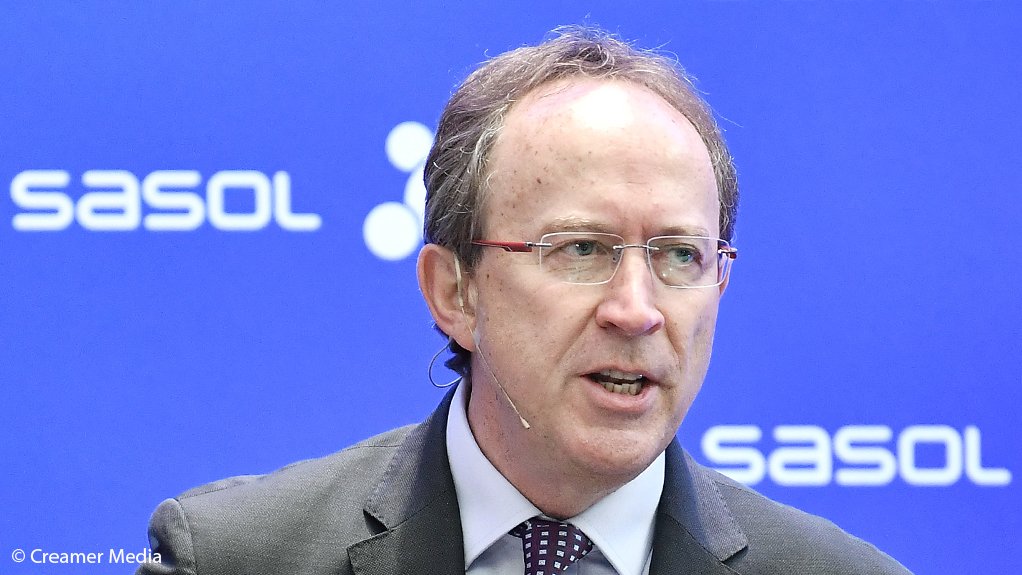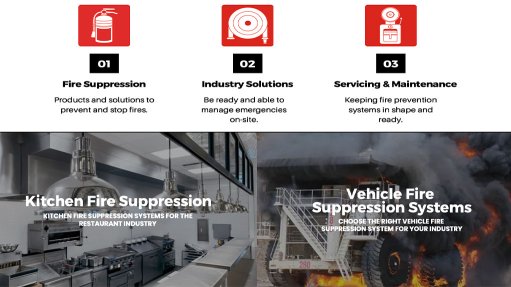Sasol says 600 MW renewables deal ‘imminent’ as it moves to cut emissions
JSE-listed group Sasol expects to conclude power purchase agreements for 600 MW of renewable energy “imminently” as it moves ahead with plans to meet a 2030 target of reducing its greenhouse-gas (GHG) emissions by 30%, while sustaining energy and chemical production volumes.
The renewables electricity will be wheeled to the group’s South African operations through the Eskom grid by 2025 and Sasol expects to add a further 600 MW of renewables by 2030.
The emission-reduction commitment, which was unveiled in 2021, has been made against a 2017 baseline of 63.9-million carbon dioxide equivalent (CO2e) tons and implies a reduction to 44.7-million CO2e tons by 2030.
The group has also pledged to be a net-zero emissions company by 2050.
Speaking to investors during a climate roundtable, CEO Fleetwood Grobler described the procurement of renewables as a key initial lever in its decarbonisation strategy to 2030, during which the group would also seek to displace coal with gas, reduce coal use through the closure of six coal-fired boilers in Secunda and implement energy efficiency projects.
The group was also investigating several green hydrogen and green hydrogen-derivative opportunities, particularly to displace the 2.4-million tons of emissions-intensive ‘grey hydrogen’ it produces currently, mainly from coal, and which the company uses to produce fuels and chemicals through its Fischer Tropsch (FT) technology.
Grobler stressed, however, that meeting the 2030 GHG-reduction target was not contingent on green hydrogen, which was being viewed as a “sweetener” during the period and was expected to contribute to its further decarbonisation only after 2030.
“Catalytic” green hydrogen projects would, however, be implemented during the current decade, including one to repurpose a 60 MW electrolyser at Sasolburg, in the Free State, to produce 3.5 t of the clean energy carrier daily. The green hydrogen arising would most likely be used to support green mobility projects in South Africa, including the fuelling of green-hydrogen mining haulage trucks.
The group would also pursue, in partnership, sustainable aviation fuel (SAF) opportunities prior to 2030, using green hydrogen in its FT process to produce jet fuel that was likely to attract a market premium from aviation companies.
A study was currently under way through the so-called HyShiFT programme to produce SAF in partnership with Linde, Enertrag and Hydregen, initially under Germany’s H2Global platform, into which the project would be bid.
Sasol was also leading a feasibility study to explore the potential for the development of a green-hydrogen derivatives export hub at Boegoebaai, in the Northern Cape, and had entered into a green-steel partnership with ArcelorMittal South Africa, for Saldanha Bay and Vanderbijlpark.
Grobler said that the reduction of electrolyser costs to produce green hydrogen to between $1/kg and $2/kg would be a key trigger for Sasol’s future green-hydrogen strategy and indicated that such pricing was likely to emerge only after 2030.
However, he noted that the incentives available in the US under the recently introduced Inflation Reduction Act would bolster the competitiveness of green hydrogen in that country and Sasol was, therefore, considering prospects for combining its FT technology with power-to-X solutions to produce green fuels and chemicals in that country.
The immediate focus in South Africa, however, would be on replacing coal electricity with renewables and moving to secure the gas it required to displace coal in its production processes at Secunda.
Recent drilling success in Mozambique had resulted in Sasol extending its gas supply plateau to 2028.
Executive VP for energy Priscillah Mabelane said the extension had given the group more time to shore up its gas supply options and also reduced the pressure to conclude a liquefied natural gas (LNG) supply agreement, which she described as ‘Plan B’ should it fail to secure more gas from southern Mozambique through a drilling programme.
Sasol expects to invest between R15-billion and R25-billion to shift from coal to gas by adding more gas reforming capacity. It expects to invest an additional R10-billion to unlock more gas supply from Mozambique.
Grobler argued that its gas strategy was unlikely to result in stranded assets as it was premised on using the existing Rompco pipeline and, should LNG be required, a flexible floating storage regasification unit. Sasol was no longer considering a pipeline to northern Mozambique to tap the gas available in the Rovuma basin.
The closure of the six coal-fired boilers would also help Sasol meet its minimum emission standard obligations.
In addition, executive VP for energy operations and technology Simon Baloyi reported that the closure would play a role in helping to reduce Sasol’s yearly coal consumption, which is expected to decline by ten-million tons yearly by 2030 relative to the 2017 baseline.
Article Enquiry
Email Article
Save Article
Feedback
To advertise email advertising@creamermedia.co.za or click here
Comments
Press Office
Announcements
What's On
Subscribe to improve your user experience...
Option 1 (equivalent of R125 a month):
Receive a weekly copy of Creamer Media's Engineering News & Mining Weekly magazine
(print copy for those in South Africa and e-magazine for those outside of South Africa)
Receive daily email newsletters
Access to full search results
Access archive of magazine back copies
Access to Projects in Progress
Access to ONE Research Report of your choice in PDF format
Option 2 (equivalent of R375 a month):
All benefits from Option 1
PLUS
Access to Creamer Media's Research Channel Africa for ALL Research Reports, in PDF format, on various industrial and mining sectors
including Electricity; Water; Energy Transition; Hydrogen; Roads, Rail and Ports; Coal; Gold; Platinum; Battery Metals; etc.
Already a subscriber?
Forgotten your password?
Receive weekly copy of Creamer Media's Engineering News & Mining Weekly magazine (print copy for those in South Africa and e-magazine for those outside of South Africa)
➕
Recieve daily email newsletters
➕
Access to full search results
➕
Access archive of magazine back copies
➕
Access to Projects in Progress
➕
Access to ONE Research Report of your choice in PDF format
RESEARCH CHANNEL AFRICA
R4500 (equivalent of R375 a month)
SUBSCRIBEAll benefits from Option 1
➕
Access to Creamer Media's Research Channel Africa for ALL Research Reports on various industrial and mining sectors, in PDF format, including on:
Electricity
➕
Water
➕
Energy Transition
➕
Hydrogen
➕
Roads, Rail and Ports
➕
Coal
➕
Gold
➕
Platinum
➕
Battery Metals
➕
etc.
Receive all benefits from Option 1 or Option 2 delivered to numerous people at your company
➕
Multiple User names and Passwords for simultaneous log-ins
➕
Intranet integration access to all in your organisation

















